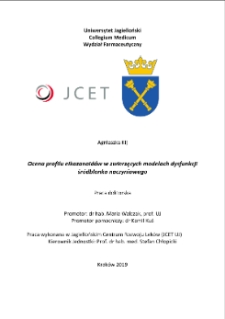Object
Title: The assessment of eicosanoid profile in animal models of endothelial dysfunction
Abstract:
In this study, two original bioanalytical methods for quantification of eicosanoids biosynthesised from arachidonic acid (AA) via different metabolic pathways were developed and validated using UPLC-MS/MS technique. The methods allowed to assess the eicosanoid profile in selected animal models of endothelial dysfunction and its changes upon pharmacological modulation of vascular function.In NO-deficient mice, the biosynthesis of eicosanoids formed by cyclooxygenase (COX) was elevated. MNA treatment improved the vessel function by activation of COX-independent mechanisms.In murine model of hypertension, angiotensin II infusion increased the biosynthesis of CYP450- derived 20-HETE. The inhibition of thrombin activity by dabigatran improved the function of endothelium by sustaining the NO bioavailability and reducing the 20-HETE production.The development of 4T1 breast cancer was associated with the elevated biosynthesis of eicosanoids formed by COX and lipoxygenase (LOX) and with the reduced production of CYP450-derived AA metabolites. The inhibition of NO synthase increased the biosynthesis of epoxyeicosatrienoic acids (EET) and 20-HETE, which probably supported the disease progression under NO-deficiency.The obtained results show the heterogeneity of eicosanoid profile in investigated murine models of endothelial dysfunction and the pharmacological modulation of vascular functi ; on indicates which AA metabolic pathways could be an effective target in the treatment of hypertension and breast cancer.
Place of publishing:
Level of degree:
Degree discipline:
Degree grantor:
Promoter:
Date issued:
Identifier:
Call number:
Language:
Access rights:
Object collections:
Last modified:
Jun 21, 2023
In our library since:
Oct 7, 2020
Number of object content hits:
8
Number of object content views in PDF format
0
All available object's versions:
http://dl.cm-uj.krakow.pl:8080/publication/4382
Show description in RDF format:
Show description in OAI-PMH format:
| Edition name | Date |
|---|---|
| ZB-131048 | Jun 21, 2023 |
Objects
Similar
Kij, Agnieszka
Paciorek, Anna
Basta, Paweł
Streb, Joanna
Glajcar, Anna
Hubalewska-Mazgaj, Magdalena

